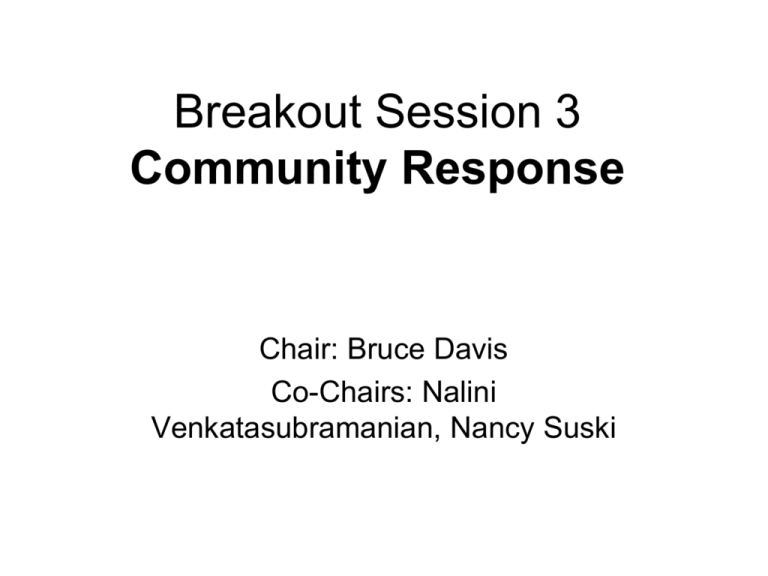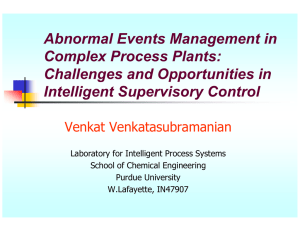Breakout Session 3 - presentation friday
advertisement

Breakout Session 3 Community Response Chair: Bruce Davis Co-Chairs: Nalini Venkatasubramanian, Nancy Suski • Goals: Community Response – Identify challenges and opportunities associated with exploiting community resources (both IT as well as social networking) for emergency management – Define the functional gaps in current UICDS capability that prevent leverage of community resources for improved situational awareness and emergency response. • Issues: – What do we mean by local IT resources and social networking? – How are social networks used prior to, during, and after a disaster? – What is the technical nature of these networks? – What risks do emergency response organizations incur by using these networks; what are some mitigation strategies? – How can these networks be incorporated into & facilitated by UICDS? – What is the adverse impact on network participants for Needed Capabilities (Gaps) • • • • • • • • Local database – parcel data, street data, infrastructure Geospatial databases – local GIS capability and the associated databases Private sector database/resources needed – must be easily accessible CAD Systems – making them talk to each other and to other systems Vet records/animal identification databases accessing smart chip technology Population point-in-time demographic - feature resource needed Hospital availability and resources NGO & volunteer services resources/capabilities • Measurements: in the field that can be transmitted through UICDS to a variety of customers – Monitoring, response, and recovery – – – in field sensors – seismic, soil moisture, full meteorological Real time traffic flow data Real time vehicle resource assessment • • • Emergency management decision support software Evacuation plan needed and/or implemented by community Modeling – natural hazard, epidemiological, infrastructure, economic, human response behavior • Social Networking sites/assets – blogs, portals, facebook, twitter, myspace, youtube, movies/photos Adding the social networking sites to a “Reverse 911” – “Phone trees” – used as an information source 211 and 311 used in San Bernardino/Riverside – Emergency and Informational reasons • • 3 Challenges • • • • • • • • • Governance structure The feeling of spam Fraud Reliability/verification Who is going to maintain/take ownership of the system? Legal liability How to prevent dependency on this Sharing security ideas – UICDS comes into play Real time monitoring systems – “sensor feeds” 4 • Where do we want to be in 5 years? • • • • • • • • • • • • • • • • • Need for a preloaded profile that filters information Dynamically developed intelligent filter Have the ability to change subscriptions as we move forward Spatial temporal tagging/tracking information/visualization Used not just for emergency or exercises Open source software – opens up the field Need to contribute to UICDS system through some service oriented web interface Measurements in the field A dynamic and intelligent coupling of infield measuring to models Models – longer term use (present status) Situational assessment that can understand trends – driven by the in situ awareness tools Resource tracking NGO & volunteer services resources/capabilities Alerting vs Activating How do we tap into these resources? Appropriate teaming/organization of government to leverage technology Command & control of ad hoc volunteer groups Value Added Services UICDS User Community Level Reality Check • It can be difficult to construct a vision of the future when the present is not what you want but it is what you know and what you have? But…. • The reality of the future it seems more possible if you can see the bridge that gets you there. – Funding – initial and maintenance – Training – Consideration for legacy systems – And finally, • It is better to implement one improvement so that it is used fully by the customer than to vision several possibilities that only just get off the ground. 8





